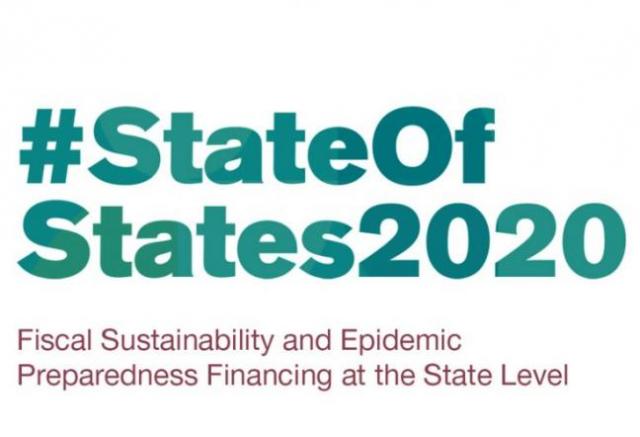
BudgIT, a civic advocacy society that uses technology to intersect citizen-engagement with improved governance has launched the 2020 edition of its annual States of States report titled Fiscal Sustainability and Epidemic Preparedness Financing at the State level. This report is BudgIT’s signature analysis that provides policy makers with robust insights on ways to implement financial and institutional reforms that will improve states’ fiscal performance and sustainability level.
Without a doubt, soaring debt burden, imprudent fiscal planning, and nearly a decade of misplaced expenditure priorities have beaten a clear path to fiscal crisis for many Nigerian states. This is veritably evident in our just released 2020 Fiscal Sustainability Index where some states rank higher than others and most are still below the sustainability point. Rivers state occupies the number #1 position on the index, followed by Anambra, Ogun and Lagos. Among the States that are not fiscally sustainable, Bayelsa, Osun, Ekiti and Plateau occupy the least positions.
From our 2020 State of States analysis, 13 states were unable to fund their recurrent expenditure obligations together with their loan repayment schedules due in 2019 with their respective total revenues. The worst hit of these 13 states are – Oyo, Kogi, Osun and Ekiti States while the other states on this pendulum are Plateau, Adamawa, Bauchi, Gombe, Cross River, Benue, Taraba and Abia.
Furthermore, of the remaining 23 states that can meet recurrent expenditure and loan repayment schedules with their total revenue, 8 of those states had really low (less than N6bn) excess revenue, that they had to borrow heavily to fund their capital projects. The worst hit are Zamfara, Ondo and Kwara who had N782.45m, N788.22m and N1.48bn left, respectively
Based on their fiscal analysis, only five (5) states – Rivers, Kaduna, Akwa Ibom, Ebonyi and Kebbi states – prioritised capital expenditure over recurrent obligations while thirty-one (31) states prioritised recurrent expenditure according to their 2019 financial statements.
“Recurrent expenditures are not necessarily a bad thing, especially when skewed towards sectors like Health and Education. However, 9 of the states in this category had overhead costs that were larger than their capital expenditures. These states are: Ekiti, Kogi, Kano, Plateau, Kwara, Nasarawa, Taraba, Adamawa and Benue” Said Abel Akeni, BudgIT’s Research Lead
All 36 states’ debts surged by 162.87% (N3.34tn), from N2.05tn in 2014 to N5.39tn in 2019, with 10 states accounting for approximately half or N1.68tn of this increase. Seven of these states are from the South while three are from the North.
“To achieve fiscal sustainability , states need to grow their IGR as options for borrowing are reduced due to debt ceilings put in place by the Federal Government to prevent states from slipping into a debt crisis. There has to be a shift from the culture of states’ overdependence on FAAC” Said Damilola Ogundipe, BudgIT’s Communications Lead
On subnational epidemic preparedness, it is important for states to prioritize health financing especially on Water, Sanitation and Hygiene (WASH). While COVID19 has garnered major attention in the last few months, it is worthy of note that states are currently battling at least 6 other deadly diseases which already have vaccines or known treatment. In 2019, all 36 states recorded 94,500 cases of the deadly Cerebrospinal meningitis (CSM), measles, lassa fever, yellow fever, monkeypox and cholera combined. It is in the self interests of State Governments to grow their IGR and also invest in appropriate health systems through their budgets and other sustainable methods
BudgIT’s Principal Lead, Gabriel Okeowo, noted that though some States have seen some improvement in their IGR between 2014 and 2019, there is still a need to put systems in place for aggressive IGR growth within the subnational economies, especially as falling crude oil prices, OPEC production cuts and other COVID-19 induced headwinds are set to impact Federal Allocations over the next two years. This paints a bleak outlook for Nigerian states who depend on FAAC allocation for their survival, even though dwindling revenue will affect all states differently.
Three states – Bayelsa, Borno and Katsina – will be worst hit by dwindling revenue as they relied on Net FAAC for 89.56%, 88.30% and 88.16% of their total revenues, respectively in 2019. Lagos, Ogun and Rivers state will be least affected as they relied on Federal Allocation (Net FAAC) for only 22.82%, 35.31% and 53.02% of their total revenues, respectively.
Support InfoStride News' Credible Journalism: Only credible journalism can guarantee a fair, accountable and transparent society, including democracy and government. It involves a lot of efforts and money. We need your support. Click here to Donate
